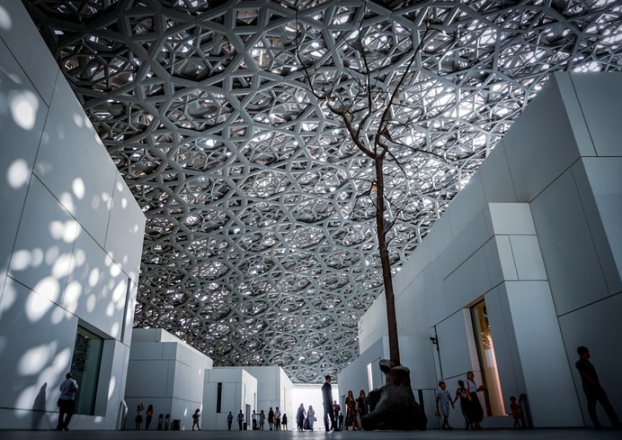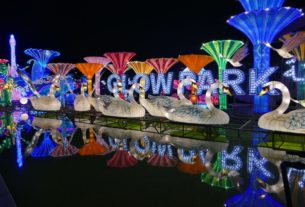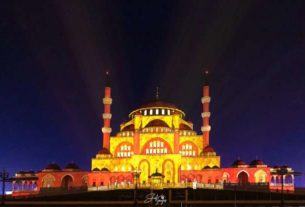Situated in the Saadiyat Island Cultural District, Abu Dhabi, UAE, Louvre Abu Dhabi is a celebration of the rich multicultural legacy of Middle East, while being a truly universal museum. Combining the best of both French and Arabic architecture and culture in its design, the Louvre Abu Dhabi showcases cultural triumphs from across the world.

The construction of the museum began in 2009 and it was opened to the public on 8th November 2017. The jaw dropping design of the Louvre Abu Dhabi is by the French architect Jean Nouvel. With a total area of 24,000 sq m and galleries occupying 8,000 sq m, it is the largest art museum in the Arabian Peninsula.
The focus of the museum is to bridge the gap between Eastern and Western art. Both ancient and modern-day works of historic, cultural, and sociological interest from all corners of the globe are on display at the Louvre Abu Dhabi.
The dome of the Abu Dhabi Louvre, which is made up of 8 different layers – four outer layers clad in stainless steel and four inner layers clad in aluminium – weighs about 7,500 tons. The perforations in the dome make the sunlight to filter into the interior of the museum to create impressive effects of light and shade. The inspiration for this design came from the sunlight passing through the leaves of date palm trees, which cause soft shadows on the ground.
The Saadiyat Island Cultural District, which hosts the Louvre Abu Dhabi, is going to be a cultural central point as more prestigious museums like the The Guggenheim Abu Dhabi and The Sheikh Zayed National Museum are going to be opened here.
A Short Introduction To The History Of World Renowned Louvre Museum

The massive, silvery dome of Louvre Abu Dhabi, with its 7850 star shaped perforations of various sizes, which appear to float in the blue waters, shimmering like a jewel, is a work of art in itself; a wonderful vision that can leave the visitor awestruck even before sampling the wealth of art treasure that it holds within its elegant art galleries. The recently opened direct extension of the Louvre museum in Paris, the Louvre Abu Dhabi captures the elegance and essence of humanity with perfection.
The original Louvre, situated in Paris, France has a rich, inspiring and long history, which we are going to explore in this short introduction to Louvre.
The Louvre royal palace is one of the largest and the most magnificent palaces in Europe. It was converted into one of the most encyclopedic and vast museums in the world in the 18th century. The Louvre museum – Musée du Louvre – is world renowned for the massive collection of art that it hosts, which include masterpieces from all around the world.
The outstanding creations that are on display in the Louvre epitomize almost all types of artworks known to mankind and represents all periods of artwork ranging from remote antiquity to the modern times. Paintings from masters like Leonardo da Vinci, Rembrandt, Rubens, Caravaggio and Raphael are on display in this glorious museum. It is an enormous treasury of art representing all civilizations.
The History of the Palace of the Louvre
The Louvre Palace was originally built as a small castle or fortress near the Seine River, on the entrance to the town, by King Philip Augustus, in the early 13th century. The fortress was built on a location at which the defenses of the city was weakest. It was enlarged as a royal residence by Charles V in 14th century.
In the 16th century, during the renaissance era, the Louvre castle was demolished and was totally renovated into a remarkable palace under Francis I. The assignment for building a new renaissance style palace was given to the architect Pierre Lescot. It was Henry IV, who was the last king to reside in the Louvre palace, who built the wing along the Seine River during early 17th century.
The beginning of the world’s largest museum
By the second half of the 17th century, the Louvre palace was used as a location to display the royal collection of artworks. When Louis XIV chose the Palace of Versailles as his household, and as the court was shifted there, the Louvre became a sort of art gallery for special guests.
It was during the French Revolution that the National Assembly – a revolutionary assembly which existed in France, from 13 June 1789 to 9 July 1789 – decreed that Louvre Palace will be used as a museum for displaying French masterpieces for public. On August 10, 1793, a part of the palace was opened as a public museum and the royal collection of Louvre, which was now a national property, was unlocked to the eyes of public.
By the later stages of French revolution, the ‘Great Gallery’, which exhibited the paintings and the ‘Small Gallery’, which exhibited the antiquities were opened to the public. The museum continued to expand and by 1803 – when it was named the Napoleonic Museum – it hosted some of the most splendid collection of masterpieces.
With the opening and unceasing development of different departments like Greek, Roman, Egyptian and Oriental antiquities, the museum soon expanded to occupy most of the palace building. New wings and buildings were built on a constant basis to accommodate the influx of both exhibits and visitors. The impressive steel and glass pyramid – designed by the Chinese American architect I. M. Pei – located in the main court, which acts as an entrance to the museum was inaugurated on 15 October 1988 and is a sight to behold. Today, the Louvre Museum in Paris is the world’s largest and most visited – about 8.1 million visitors in 2017 – art museum.
The Louvre museum holds more than 38,000 objects ranging from those from prehistoric times to the 21st century. The exhibits in the museum are classified into broad departments like Egyptian antiquities, Near Eastern antiquities, Greek, Etruscan, and Roman antiquities, Islamic art, Sculpture, Decorative arts, Prints and drawings and Paintings.






1 thought on “Louvre Abu Dhabi – The Universal Museum”
Comments are closed.